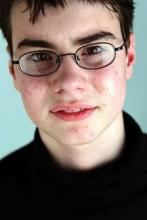Acne severity, frequency, and beliefs about the effect of external factors, such as cleansing habits, all play a part in how likely adolescents are to seek help for their acne.
The findings come from a survey of more than 1,000 middle and high school–aged teens in New Jersey. The study was published online in the journal Pediatric Dermatology (2010 Aug. 26 [doi:10.1111/j.1525-1470.2010.01286.x]).
"Our study demonstrated that grade of acne, knowledge, and beliefs play a role in help-seeking behaviors, which vary to a significant extent by race and ethnicity," wrote Carol E. Cheng and her coinvestigators. Ms. Cheng is a medical student at Boston University. "Better education about how to manage their acne effectively, and guiding appropriate patients to health care providers, may be important ways to decrease the risk of racial disparities in acne morbidity."
Students at five middle schools and three high schools in New Jersey were asked to complete an anonymous survey, in which they were asked questions about their acne severity, frequency, treatment, beliefs about external factors affecting acne, and perception of the psychosocial impact of acne. Students self-reported demographic information on age, gender, grade, ethnicity (Hispanic, not Hispanic, don't know), and race (American Indian, Native Hawaiian, white, black/African American, more than one race, or unknown).
A total of 1,214 students in grades 6-12 completed the survey; their ages ranged from 10 to 18 years. Roughly half (52%) were male. Almost a quarter of the students (24%) were Hispanic, 40% were white, 14% were Asian, and 10% were black.
Students were asked to rate their acne frequency as never, rarely, sometimes, often, or always. Roughly three-quarters (76%) reported that they had acne of some frequency. They were also asked to rate the severity of their acne as none, mild, moderate, or severe. In all, 65% reported that they had acne of some severity.
"The largest differences appeared in the frequency and severity of black respondents, compared with other races, which suggest that this population may be less affected or may perceive themselves to be less affected," the investigators wrote. Black students were 14% less likely than nonblack students to report acne of any frequency. Similarly, black students were 18% less likely than white students to report acne of any severity.
Participants were also asked to report whether they visited a pediatrician, dermatologist, or another type of health professional, or had never seen a health professional for their acne. Most (83%) reported they had not seen a health professional for their acne. This value was similar across ethnicities and races.
Self-reported acne had an impact on the likelihood of respondents having seen a physician and also on the type of physician seen. Students who reported having acne of some severity were more likely to have seen a physician, compared with those who reported not having acne (21% vs. 8%, respectively). Increased acne severity corresponded with increased likelihood of seeing a dermatologist.
Black students with mild or moderate acne were more likely to have seen a health care professional for their acne, compared with white students (relative risk 3.63 and 3.06, respectively). In contrast, Hispanic students with mild or moderate acne were less likely to see a health professional for their acne, compared with non-Hispanic students (RR 0.56 and 0.47, respectively).
Students were also asked if they treated their own acne, followed a health professional's advice, did both, or did something else. There were no significant differences by race or ethnicity with regard to treatment advice.
The researchers asked the students to rate how much they believed that certain factors affected their acne. These included poor cleansing habits, poor dietary habits, decreased sleep, increased stress, increased exercise, increased drinking of water, increased face touching, increased face washing, increased tanning, and pimple popping.
A majority of students believed that the following factors worsened acne: poor cleansing habits (77%), poor dietary habits (56%), stress (60%), increased face touching (70%), and pimple popping (70%).
"Notably, black respondents in 6/10 cases were least likely to believe that a given factor worsened acne relative to other groups, whereas Asian respondents in 7/10 cases were more likely to believe that a given factor worsened acne relative to other groups," the researchers noted.
White students were more likely to have seen a health care professional and follow a treatment suggestion from a physician if they believed external factors affected acne. Black students who believed external factors affected acne were also more likely to follow a treatment suggestion from a physician. "Notably, Asian respondents did not attribute their help-seeking behavior or treatment decisions to any external factors," the investigators reported.


